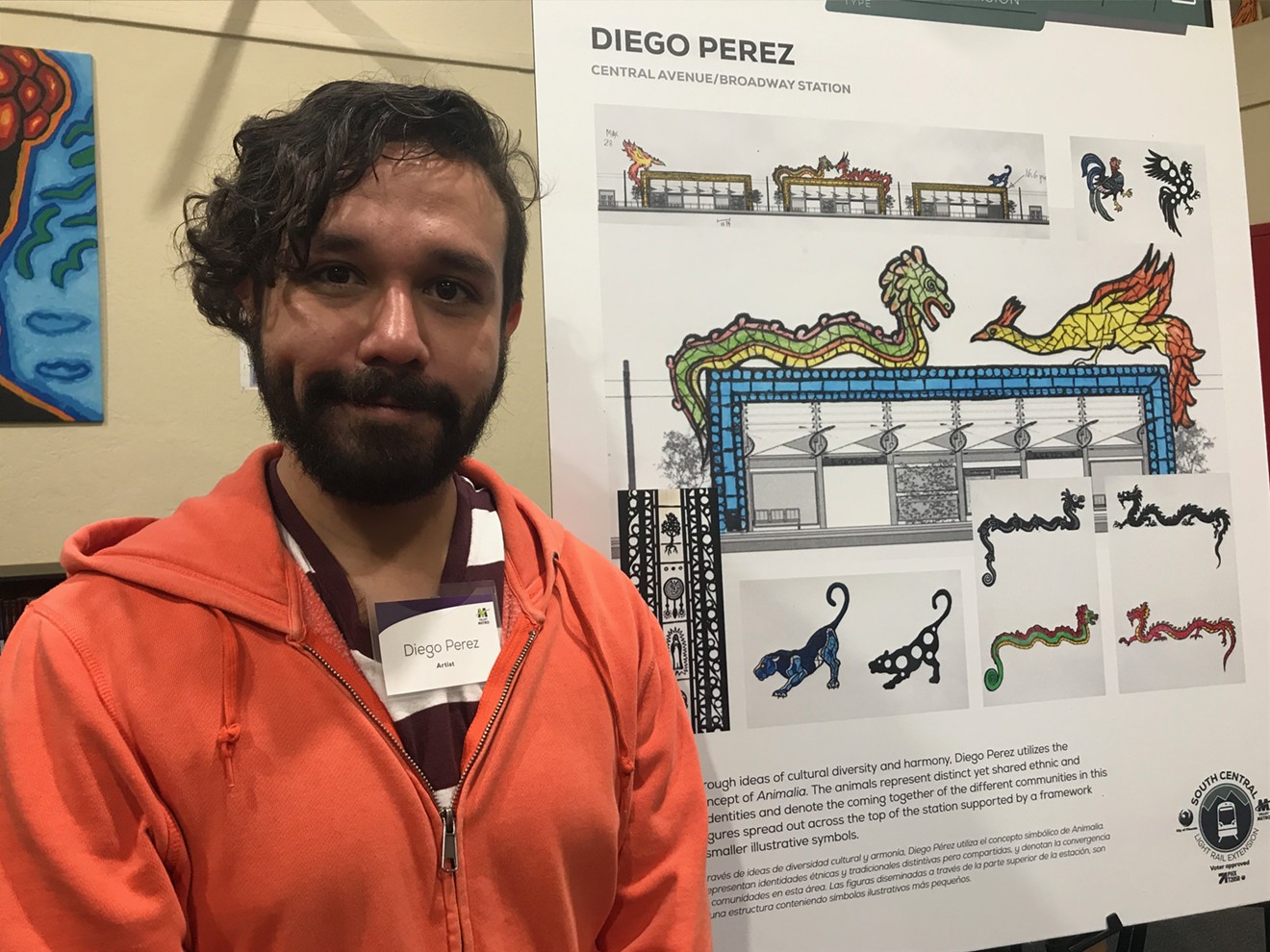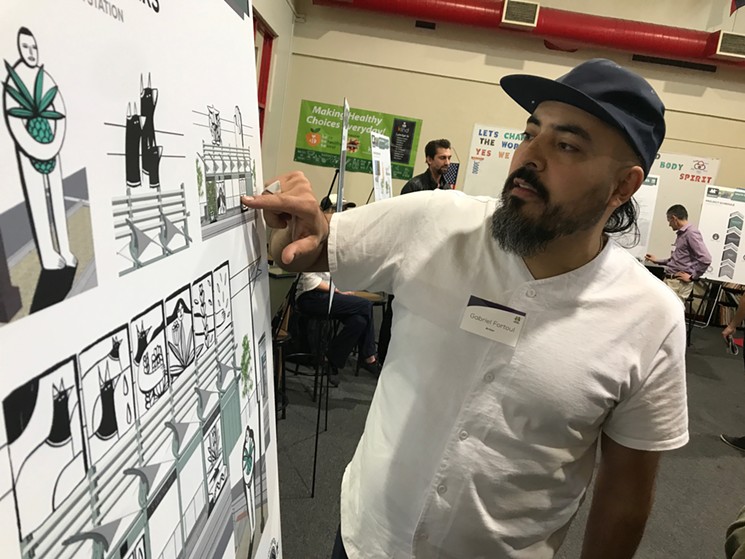Now, Valley Metro has chosen three additional artists, whose work will be part of a new downtown hub, where the South Central extension will connect with the downtown transit system. The hub is bounded by Central and First avenues, between Washington and Jefferson streets.
That's where Janelle Stanley of Phoenix, Amanda Clayton of Tempe, and Los Angeles-based Aphidoidea Creative Collaborative will be bringing their designs to life.
The artists were selected through a competitive process after responding to a call for art that closed on April 12. Valley Metro announced the winners on May 17, but has yet to share their designs.
The artists announced in August will present the latest iterations of their designs during a public meeting later this year. The date for that meeting has yet to be announced. But members of the community have already seen what they're planning, and offered input on the designs.
Several of the artists revealed their preliminary design plans during a community meeting held on February 3 at Reyes Maria Ruiz Leadership Academy. More than three dozen community members attended the gathering.
The artist lineup includes some of Phoenix’s best-known artists, including the Fortoul Brothers. Their recent works include the Freedom is Back mural located just south of Valley Metro’s Central Avenue and Roosevelt Street station, and a large-scale mural they’re still completing at Garfield Elementary School.
Other Valley artists who shared designs that day include Diego Perez, Hugo Medina, Martin Moreno, and Emily Costello. Moreno and Costello, both longtime residents of south Phoenix, are working together on a single design.

Brooklyn artist Mark Reigelman with early designs for a light-rail station in south Phoenix.
Lynn Trimble
Their works will be featured at stations along a six-mile corridor, running primarily along Central Avenue between Roosevelt Street and Baseline Road. The route will include 11 stations, and be integrated with the downtown transit hub.
The design phase will continue through 2019, according to plans posted on the Valley Metro Light Rail website. Construction is scheduled for 2019 through 2023.
For now, chosen artists are finessing the designs they shared during the February gathering. All were chosen through a competitive process that started with an open call to artists.
“It’s an honor for us to represent our community and give back to our community,” Costello says. “We want to create a historical landmark that includes all our cultures.”
The Fortoul Brothers were chosen to design the Central Avenue and Lincoln Street station. They’re planning to create their first large-scale sculptural installation, comprising nature-inspired iconography that’s prevalent in their larger body of work.
Preliminary designs by Gabriel and Isaac incorporate animals, plants, people, and natural elements including water. It’s possible that distinct figures will rise above the station, but they could create a panel with continuous imagery to rise above the station instead.
It’s possible they’ll place additional sculptural elements along the platform. At this point, the materials they plan to use include stone, concrete, and metal. So it’s a big change for the artists, who typically create paintings, prints, and small wooden sculptures.
“We want to create something that will become iconic to this part of Phoenix, which is going through a lot of changes right now,” Gabriel says. “We want to put Phoenix on the map as a major art destination.”
By the time Gabriel presented their plans at the February meeting, they’d already evolved. So, although you can see an initial concept in the PowerPoint presentation that Valley Metro has online, it’s too soon to know exactly what their station design will look like.
“Our sketches have already advanced beyond that, so there will be some surprises.”

Community members talk with Blessing Hancock during a February meeting about future light-rail art.
Lynn Trimble
Tucson-based Blessing Hancock is designing the First Avenue and Lincoln Street station, along a short portion of the route that strays from Central Avenue. Hancock founded Skyrim Studio, which specializes in large-scale, site-specific sculptural installations, in 2008.
Hancock envisions three towers featuring geometric designs inspired by the architecture of three historic buildings – the Sun Merchantile Building (1929), Phoenix Seed & Feed Warehouse (1926), and the Bell Laundry Building (1918). The latter was transformed through adaptive reuse, and became Bentley Projects in 2004.
Her tower designs include brightly colored, polycarbonate interiors, and exterior metal designs with cutouts that reveal the colors beneath them. She created something similar in Colorado, using patterns inspired by bioscience and technology. That 2016 installation is titled Biota.
The Central Avenue and Buckeye Road station is being designed by Mark Reigelman. He’s a Brooklyn-based artist whose previous commissions include New York Public Library, San Diego International Airport, and the Rock and Roll Hall of Fame and Museum in Cleveland.
Reigelman describes south Phoenix as “an isolated yet vibrant and enduring community” in his presentation materials for Valley Metro. Hence, his design reflects the concept of barriers, while “highlighting the importance of exchange, interaction, and shared experiences.” He’ll create the final design after working with three south Phoenix artists on temporary art projects that explore “themes of community, migration, and housing.”
His preliminary plans put birds, including a copper bird that could stand 10 to 13 feet tall, front and center. “I’m interested in birds generally, and there’s a history of birds being representational of indigenous cultures,” Reigelman says. “Birds are a symbol of adaptability and endurance and struggle.”
Like all the artists, he’s working to reference specific elements of south Phoenix culture, both past and present.

Priscila De Carvalho of New York City (right) talks about her early design for the south Phoenix light-rail line.
Lynn Trimble
The panels will depict images rooted in the region’s history and culture. “I was inspired by prehistoric and modern American Indians and plants, as well as endangered birds,” she says. She’s also paying homage to Hohokam culture. “I want to create a storyline that connects past and present, and inspires an appreciation of nature and native American cultures.”
Phoenix-based Diego Perez designed the Central Avenue and Broadway Road station, using animals prevalent in the mythology of five cultures listed in his presentation materials: Hispanic, Afro-American, Native-American, American, and Oriental.
Perez envisions creating large steel and ceramic frameworks with colorful imagery of animals including the dragon, panther, rooster, serpent, and rising Phoenix bird. He’s also hoping to incorporate iconic symbols such as the Virgin of Guadalupe and the Statue of Liberty.
“Animals are always in harmony with their environment, and this is a way to explore the harmony of heritage,” Perez says.

Martin Moreno talks with community members about a light-rail design created with Emily Costello.
Lynn Trimble
Conceptually, they’re working with the idea of roots – which includes education, faith, family, and the land. Like Perez, they plan to honor the diverse heritage of south Phoenix, including its Native American, Japanese, Latino, and African-American residents.
The team plans to create six steel laser-cut panels framed by tiles. They’ll be holding workshops for community members who want to make tiles for the project. “You’ll see our ancestral roots in our design, and the strength our ancestry brings into a future of life and hope,” Costello says.

Hugo Medina with an early design for the light-rail station at Central and Southern avenues.
Lynn Trimble
Medina drew inspiration from a children’s book called The Butterfly Garden, and the migration of monarch butterflies between Canada, the United States, and Mexico. He’s designed steel panels featuring the images of butterflies, roses, and other imagery. “The garden is us,” Medina says. “Children need families and community to grow.”
And he’s conceived a wave of butterflies flying over the station. That piece was inspired by a sculpture made with silver kitchen utensils, which is installed along part of the ceiling inside the Phoenix Children’s Museum. He also drew inspiration from a Daniel Martin Diaz piece along the Mesa light-rail line.
Valley Metro officials will reveal the 60 percent designs during a public meeting in late summer. That gathering will also include the launch of a business-assistance program for businesses located along the light-rail construction route.
During late summer, officials will also share 30 percent designs for the Central Avenue and Baseline Road station, park-and-ride site, and traction power substations. Expect to see 90 percent designs in spring 2019.
Community members can find preliminary designs and public meeting information on the Valley Metro Light Rail website.













